Laifa Tao
UBMF: Uncertainty-Aware Bayesian Meta-Learning Framework for Fault Diagnosis with Imbalanced Industrial Data
Mar 14, 2025Abstract:Fault diagnosis of mechanical equipment involves data collection, feature extraction, and pattern recognition but is often hindered by the imbalanced nature of industrial data, introducing significant uncertainty and reducing diagnostic reliability. To address these challenges, this study proposes the Uncertainty-Aware Bayesian Meta-Learning Framework (UBMF), which integrates four key modules: data perturbation injection for enhancing feature robustness, cross-task self-supervised feature extraction for improving transferability, uncertainty-based sample filtering for robust out-of-domain generalization, and Bayesian meta-knowledge integration for fine-grained classification. Experimental results on ten open-source datasets under various imbalanced conditions, including cross-task, small-sample, and unseen-sample scenarios, demonstrate the superiority of UBMF, achieving an average improvement of 42.22% across ten Any-way 1-5-shot diagnostic tasks. This integrated framework effectively enhances diagnostic accuracy, generalization, and adaptability, providing a reliable solution for complex industrial fault diagnosis.
Pre-Trained Large Language Model Based Remaining Useful Life Transfer Prediction of Bearing
Jan 13, 2025



Abstract:Accurately predicting the remaining useful life (RUL) of rotating machinery, such as bearings, is essential for ensuring equipment reliability and minimizing unexpected industrial failures. Traditional data-driven deep learning methods face challenges in practical settings due to inconsistent training and testing data distributions and limited generalization for long-term predictions.
LLM-R: A Framework for Domain-Adaptive Maintenance Scheme Generation Combining Hierarchical Agents and RAG
Nov 07, 2024Abstract:The increasing use of smart devices has emphasized the critical role of maintenance in production activities. Interactive Electronic Technical Manuals (IETMs) are vital tools that support the maintenance of smart equipment. However, traditional IETMs face challenges such as transitioning from Graphical User Interfaces (GUIs) to natural Language User Interfaces (LUIs) and managing complex logical relationships. Additionally, they must meet the current demands for higher intelligence. This paper proposes a Maintenance Scheme Generation Method based on Large Language Models (LLM-R). The proposed method includes several key innovations: We propose the Low Rank Adaptation-Knowledge Retention (LORA-KR) loss technology to proportionally adjust mixed maintenance data for fine-tuning the LLM. This method prevents knowledge conflicts caused by mixed data, improving the model's adaptability and reasoning ability in specific maintenance domains, Besides, Hierarchical Task-Based Agent and Instruction-level Retrieval-Augmented Generation (RAG) technologies are adopted to optimize the generation steps and mitigate the phenomenon of hallucination caused by the model's Inability to access contextual information. This enhancement improves the model's flexibility and accuracy in handling known or unknown maintenance objects and maintenance scheme scenarios. To validate the proposed method's effectiveness in maintenance tasks, a maintenance scheme dataset was constructed using objects from different fields. The experimental results show that the accuracy of the maintenance schemes generated by the proposed method reached 91.59%, indicating which improvement enhances the intelligence of maintenance schemes and introduces novel technical approaches for equipment maintenance.
LLM-based Framework for Bearing Fault Diagnosis
Nov 05, 2024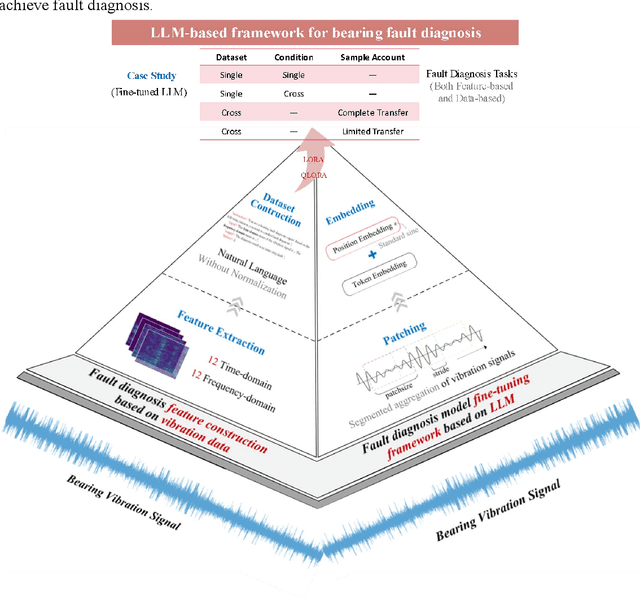
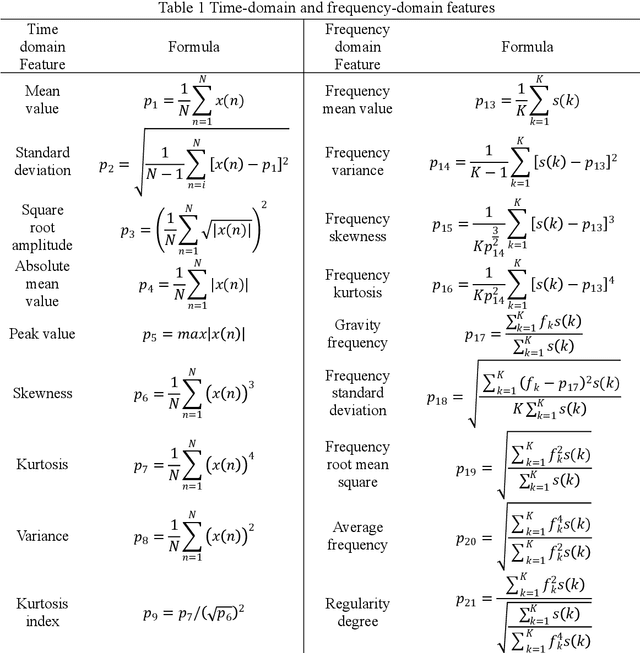

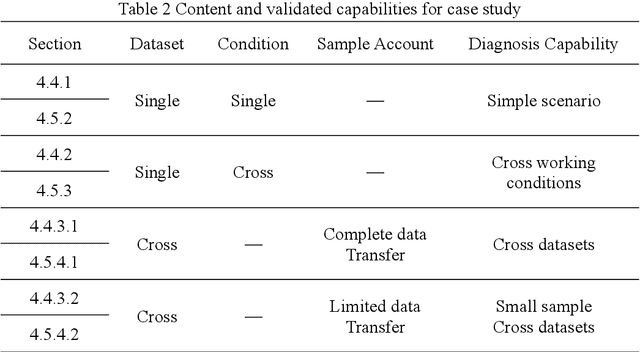
Abstract:Accurately diagnosing bearing faults is crucial for maintaining the efficient operation of rotating machinery. However, traditional diagnosis methods face challenges due to the diversification of application environments, including cross-condition adaptability, small-sample learning difficulties, and cross-dataset generalization. These challenges have hindered the effectiveness and limited the application of existing approaches. Large language models (LLMs) offer new possibilities for improving the generalization of diagnosis models. However, the integration of LLMs with traditional diagnosis techniques for optimal generalization remains underexplored. This paper proposed an LLM-based bearing fault diagnosis framework to tackle these challenges. First, a signal feature quantification method was put forward to address the issue of extracting semantic information from vibration data, which integrated time and frequency domain feature extraction based on a statistical analysis framework. This method textualized time-series data, aiming to efficiently learn cross-condition and small-sample common features through concise feature selection. Fine-tuning methods based on LoRA and QLoRA were employed to enhance the generalization capability of LLMs in analyzing vibration data features. In addition, the two innovations (textualizing vibration features and fine-tuning pre-trained models) were validated by single-dataset cross-condition and cross-dataset transfer experiment with complete and limited data. The results demonstrated the ability of the proposed framework to perform three types of generalization tasks simultaneously. Trained cross-dataset models got approximately a 10% improvement in accuracy, proving the adaptability of LLMs to input patterns. Ultimately, the results effectively enhance the generalization capability and fill the research gap in using LLMs for bearing fault diagnosis.
An Outline of Prognostics and Health Management Large Model: Concepts, Paradigms, and Challenges
Jul 01, 2024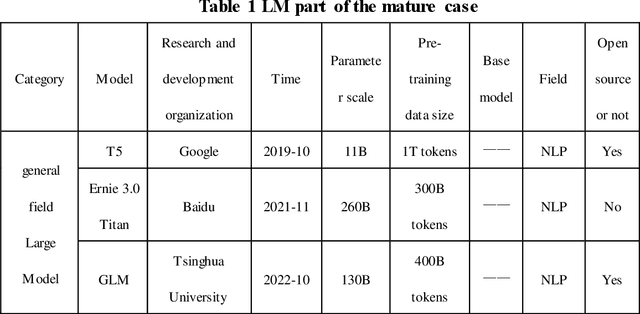
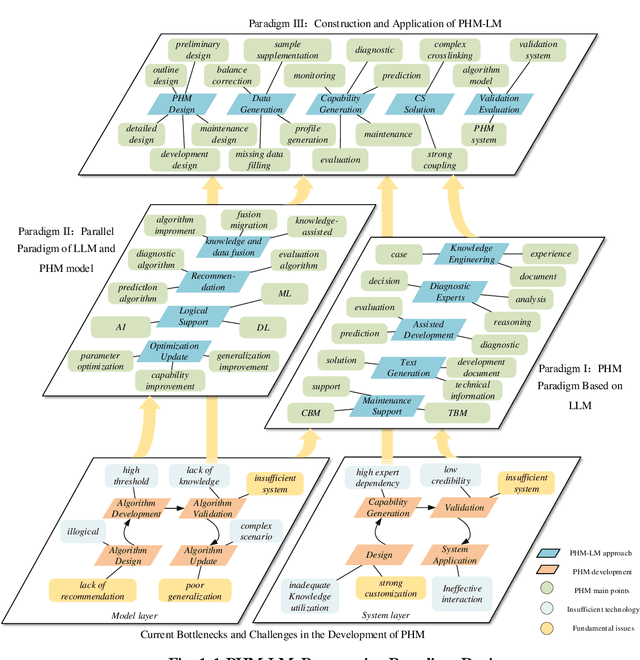
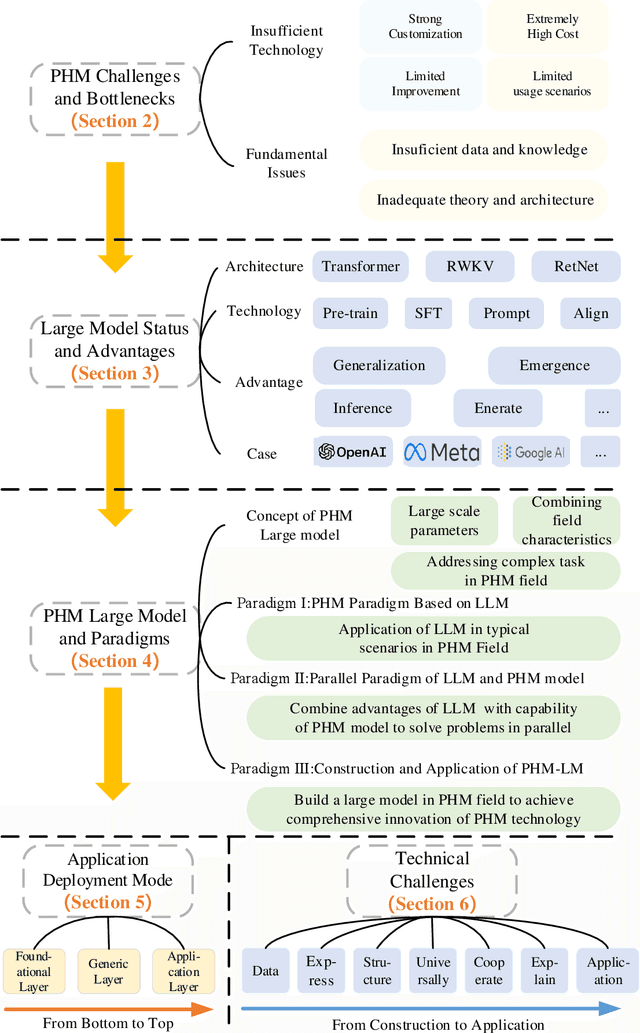
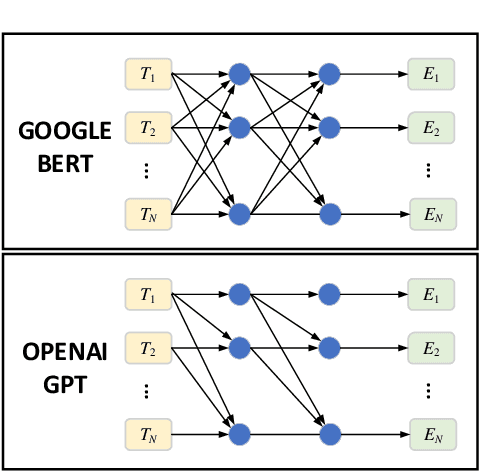
Abstract:Prognosis and Health Management (PHM), critical for ensuring task completion by complex systems and preventing unexpected failures, is widely adopted in aerospace, manufacturing, maritime, rail, energy, etc. However, PHM's development is constrained by bottlenecks like generalization, interpretation and verification abilities. Presently, generative artificial intelligence (AI), represented by Large Model, heralds a technological revolution with the potential to fundamentally reshape traditional technological fields and human production methods. Its capabilities, including strong generalization, reasoning, and generative attributes, present opportunities to address PHM's bottlenecks. To this end, based on a systematic analysis of the current challenges and bottlenecks in PHM, as well as the research status and advantages of Large Model, we propose a novel concept and three progressive paradigms of Prognosis and Health Management Large Model (PHM-LM) through the integration of the Large Model with PHM. Subsequently, we provide feasible technical approaches for PHM-LM to bolster PHM's core capabilities within the framework of the three paradigms. Moreover, to address core issues confronting PHM, we discuss a series of technical challenges of PHM-LM throughout the entire process of construction and application. This comprehensive effort offers a holistic PHM-LM technical framework, and provides avenues for new PHM technologies, methodologies, tools, platforms and applications, which also potentially innovates design, research & development, verification and application mode of PHM. And furthermore, a new generation of PHM with AI will also capably be realized, i.e., from custom to generalized, from discriminative to generative, and from theoretical conditions to practical applications.
 Add to Chrome
Add to Chrome Add to Firefox
Add to Firefox Add to Edge
Add to Edge